|
E
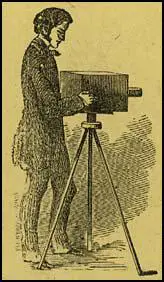
An engraving showing a
daguerreotypist making a portrait.(c1853)
|
Robert
Farmer - An
Early
Brighton Photographer
Robert
Farmer was one of the first residents of Brighton to challenge
the monopoly of William Constable, who, armed with
a licence from Richard Beard, had ran the only photographic
portrait studio in the town from 1841 to 1851. William Constable,
the proprietor of the Photographic Institution at 57 Marine
Parade, had reportedly paid Beard one thousand pounds for
the exclusive right to take daguerreotype portraits in Brighton.
Under the terms of Beard's licence, no other photographer
was permitted to use the daguerreotype process to make
portraits in the town.
In July 1852, Joseph
Meurant, an itinerant daguerreotype artist from France,
had set up a temporary 'Daguerreotype Room' at 131/2
East Street, Brighton, where for the next eight months
he took a "correct likeness" for as little as 5
shillings (25 p.). William Constable had originally charged
21 shillings (£1.05 p.) for a cased daguerreotype portrait,
but a few years later he had reduced his set price to 12s
6d, " to possess himself of the patronage of the middle
classes."
In an advertisement
placed in the Brighton Herald, Joseph Meurant announced
that he would be leaving the town on 15th March, 1853. William
Constable probably breathed a sigh of relief when he heard
that his only rival in the production of daguerreotype portraits
was planning to move on to another town.
However, by the first week of March 1853, another photographic
competitor in the form of Robert Farmer, a 30 year
old chemist, had announced that he would be taking daguerreotype
portraits for the remarkably low price of 2s 6d for each portrait,
at his shop in North Street, Brighton.
|
Robert
Farmer - Brighton Chemist 1852-53
Robert Farmer was born in 1823, probably in South London. A child
with the same name was born to Robert and Maria Farmer on 15th February
1823 and the baby was baptised at the Church of St George the Martyr
in Southwark on 25th May 1823.
Robert Farmer was a chemist by profession. Robert Farmer was not resident
in Brighton at the time of the 1851 Census, but by the summer of 1852
he was working as a chemist at 59 North Street, opposite the Unicorn
Inn. The shop at 59 North Street was previously occupied by William
Smallcombe Passmore of Somerset, a chemist and druggist, who together
with his brother John George Passmore, a surgeon, had been working
in Brighton since the early 1840s.
On 29th July 1852, Robert Farmer, Chemist of 59 North Street, Brighton,
announced that he was working as an "agent for Mrs H. Linsted,
Professional Rubber and attendant upon persons afflicted with spinal
affections (ailments) and weak joints."
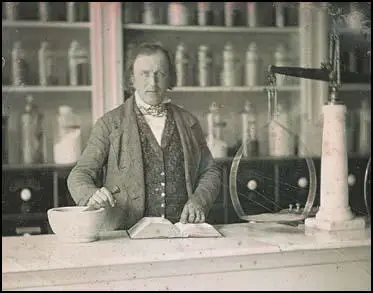
Chemist
at Work. A daguerreotype of 1852 [ GEORGE
EASTMAN HOUSE ]
Robert Farmer carried on solely as a chemist at his shop in North
Street for the next seven months. On 3rd March 1853, Robert Farmer
announced in the Brighton Gazette that daguerreotype portraits
would be "taken daily" at his gallery at 59 North Street.
Farmer's gallery was open from ten to four o'clock. He charged between
3s 6d and 10s 6d (121/2 p - 52 1/2
p.) for a daguerreotype portrait and advised customers that a sitting
would take no more than ten seconds.
Robert Farmer - A Daguerreotype Artist in 1853
Robert Farmer began taking daguerreotype portraits in the early
months of 1853 and by November he was firmly established as a photographic
artist in Brighton. By November 1853, his premises at 59 North
Street were known as "Mr. Farmer's Daguerreotype Rooms"
and one room had been specifically "designed and built expressly
for the purpose of taking fine portraits in all weathers." [By
February 1854, Farmer had also constructed a photographic glass house
at 59 North Street]. In an advertisement in the Brighton Herald
dated 26th November 1853, Robert Farmer declared proudly that
he was using "Apparatus of very superior construction"
to "ensure a fine portrait" in all weathers and conditions.
Another advertisement mentions that Farmer was using Voigtlander's
celebrated camera. (Viennese instrument maker Peter von Voigtlander
(1812-1878) had introduced cameras with a Petzval lens which had been
specifically designed for portraiture.)
|
The Voigtlander Camera
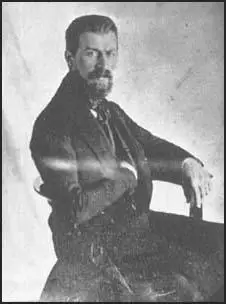
A daguerreotype portrait
of
Peter von Voigtlander ( 1812-1878 ).
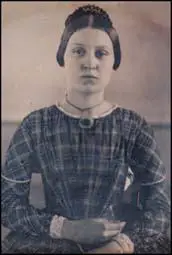
Daguerreotype by an unknown
photographer.
Robert Farmer established himself
as a daguerreotypist in Brighton by producing small and simple
portraits at very low prices.
|
.
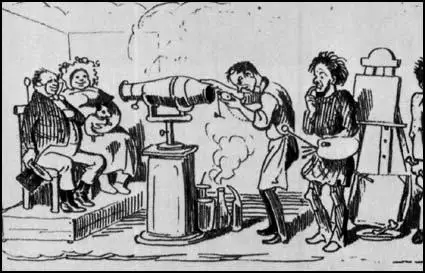
" The Photographer
deprives the Artist of his Livelihood." A cartoon by
Thomas Hosemann, which features Voigtlander's portrait camera(1843)
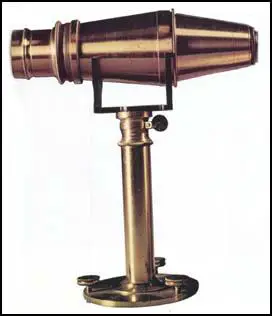
Voigtlander's early
portrait camera.
|
Farmer's
premises at 59 North Street also incorporated a picture gallery where
a "collection of photographic portraits, taken plain or in
colours, by competent Artists" were on display. Robert Farmer
was also "exhibiting to Amateurs and Ladies and Gentlemen
interested in the art, his CALOTYPE Views of the Pavilion, the Railway
Terminus etc, taken by Gustave le Gray's new waxed-paper process",
and "his DAGUERREOTYPE views of the Pavilion, and of the Old
Church previous to its being restored". Additionally, Farmer
provided "every description of apparatus" and offered
lessons in the art of photography, promising to give "practical
and theoretical instructions in the art."
By the end of 1853, Robert Farmer had a number
of competitors, both in the supply of photographic equipment and the
taking of portraits. In August 1853, Lewis Dixey, an Optician
and Mathematical Instrument Maker of 21 Kings Road, Brighton was selling
photographic apparatus and materials and offering to provide "every
requisite for practising this most interesting art." By the beginning
of 1854 Dixey was also listed as a daguerreotype artist.
William Lane of Brighton had described himself as a photographer
in the national press as early as September 1852, but up until October
1853 his advertisements in local newspapers only mention the provision
of photographic equipment and make no reference to making portraits
by the daguerreotype process. Beard's patent on the daguerreotype
process expired on 14th August 1853. In an advertisement placed in
the Sussex Advertiser on 12th November 1853, William Lane offered
to provide "a first class daguerreotype portrait in a handsome
French case for two shillings."
In his advertisements, William Lane made the claim that his photographic
depot at 213 Western Road, Brighton was "the only establishment
in England where a warranted Portrait can be had for TWO SHILLINGS."
In December 1853, Edward Collier, a daguerreotype artist of
58 Kings Road, declared that he was producing "the only real
cheap daguerreotype portraits in Brighton" and argued that his
portraits were sold "at prices so reasonable to be within
the reach of all classes of the community."
Farmer responded to the claims of his rivals by reducing the price
of his daguerreotype miniature portraits. In November 1853, a daguerreotype
portrait in 'a neat case' would cost 1s 6d at Mr Farmer's Daguerreotype
Rooms. On 19th November 1853 in the Brighton Herald, Robert
Farmer was offering "a first-rate daguerreotype portrait for
ONE SHILLING, including elegant case." In a space of nine
months, Farmer had brought down the price of a daguerreotype portrait
taken in his studio from 2s 6d to 1s.
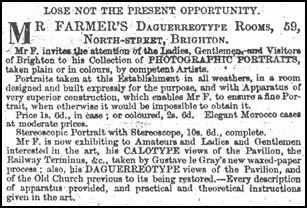
Advertisement
for Mr Farmer's Daguerreotype Rooms at 59 North Street, Brighton.The
Brighton Herald 26 November 1853.
Farmer's Photographic
Prints on Paper 1853-1855
Although Robert Farmer called his establishment in North Street, "Mr
Farmer's Daguerreotype Rooms", he was not unfamiliar with other
photographic processes. As a chemist, Farmer was probably well informed
about William Henry Fox Talbot's photographic negative/positive process
and Frederick Scott Archer's experiments with collodion glass negatives.
By 1853, the young chemist had already employed paper negatives in
the production of calotype photographs.
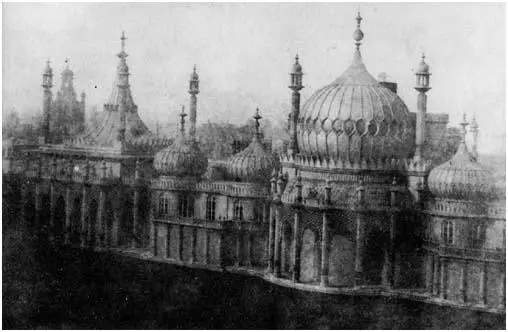
An early calotype of Brighton's
Royal Pavilion, probably taken by William Henry Fox Talbot (c1846).
In November 1853, Farmer was advertising his calotype views of the
Royal Pavilion and Brighton's Railway Station, taken by Gustave Le
Gray's waxed-paper process. Le Gray had published details of
his waxed paper process in December 1851. Le Gray used a thinner type
of paper than Talbot and the resulting photographic prints were sharper
than the grainy Talbotypes. Farmer relied on the daguerreotype process
to make portraits and he continued to describe his establishment as
"Farmer's Daguerreotype Portrait Rooms" up to 1855. However,
during this time, Robert Farmer did use alternative photographic processes
to produce views of Brighton. The daguerreotype could be taken
in seconds and produced sharp detailed images and therefore was ideal
for portraiture; the calotype was more suited for taking photographs
of buildings and landscapes. It was more convenient to use Le Gray's
paper process on the streets of Brighton to take views. A daguerreotype
was unique and the process itself did not allow multiple copies. Le
Gray's waxed paper negatives and Archer's collodion glass negatives
could both be used to produce a large number of photographic prints.
Farmer was quick to recognise the commercial potential of printing
from negatives.
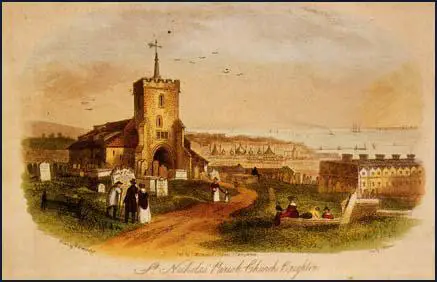
A coloured
print from the early 1850s showing St Nicholas Church in Brighton.
Between 1852 and 1853 the parish church of St Nicholas was restored
and altered by Richard Cromwell Carpenter (1812-1855). In
November 1853, Robert Farmer exhibited
at his North Street gallery, a daguerreotype view of St Nicholas which
showed " the Old Church previous to its being restored. "
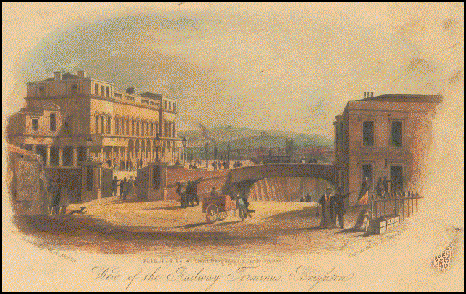
View of
the Railway Terminus, Brighton by Richard H Nibbs (1816-1893). Around
the time this print was made in the early 1850s,Robert Farmer was
exhibiting calotype views of the Railway Terminus. Farmer later published
his photographic views of Brighton landmarks such as the Railway Station
and St Nicholas Church, which he hoped would rival these engraved
prints.
On 13th November 1855, a notice appeared in 'The Times', advertising
Farmer's Photographic Printing Office at 59 North Street, Brighton.
From his printing office, Farmer produced photographic prints of Brighton
Beach and other views of Brighton. In his 1855 advertisement, Farmer
makes it clear that his photographic views of Brighton were "permanent
positives printed from glass or paper negatives, in the best manner
and possessng the most brilliant tones."
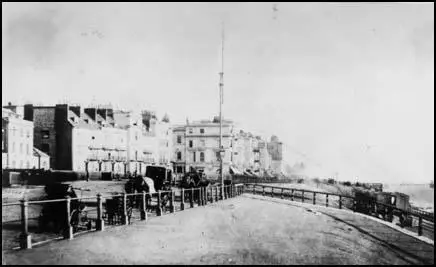
A photographic
view on paper showing the West Battery on Brighton's Kings Road. This
early photograph was taken around 1855 when Robert Farmer was producing
photographic prints of Brighton views from his premises at 59 North
Street, Brighton.
Farmer sold his 'handsomely mounted' photographic views of Brighton
measuring 8 inches by 6 inches (20.5cm x 15.2cm) at the rate of 24
shillings a dozen (£1.20p for 12 copies). Farmer's smaller,
unmounted photographic views were considerably cheaper. For example,
photographic prints of Brighton Beach, which could be pasted into
scrap books or fixed in albums, were advertised at 9 shillings a dozen
(45 p for 12 copies).
Family matters
We know that Robert Farmer was a family man. He married a woman named
Harriot (Harriet) Lovell and the couple were the parents of at least
three children.
Robert Farmer and his wife Harriet are recorded as the parents of
Walter Lovell Farmer, who was baptised at Brighton's Chapel Royal
on 30th August 1854. A second son, Ernest Howard Farmer, was baptised
at the same chapel on 9th July 1856. In the register for these baptisms,
Robert Farmer's occupation is given as 'Chemist', but when the couple's
last child, Herbert Leighton Farmer was baptised on 10th February
1858, the clerk entered the father's profession as 'Artist.'
The Farmer family may have lived at Robert Farmer's business premises
at 59 North Street for a time, but in Taylor's Directory of 1854,
an additional address of 114, North Street is given. In 1857,
Robert Farmer is recorded at 59 North Street in Brighton's Register
of Electors. However, Melville's Directory of 1858 lists Robert Farmer's
photographic galleries at 59 and 62 North Street, but in the street
directory the residential address is recorded as 114 North Street.
Living next door at 116 North Street was Mrs H Linsted, the professional
rubber or masseuse, for whom Robert Farmer acted as an agent.
Of Robert Farmer's three sons, only Ernest Howard Farmer appears
to have survived into adulthood. In the 1881 Census, Ernest Farmer
is recorded as a 'physicist' aged 24, living at 51 Davyell Road, Lambeth.
Also residing in Lambeth at the time of the 1881 Census is Harriet
Farmer, a charwoman, a widow aged 64. Her place of birth is given
as Walton-on-Thames, Surrey. As yet, there is no firm evidence that
this Harriet Farmer was the wife of Robert Farmer.
Robert Farmer -
Daguerreotype Portrait Artist 1854 -1856
In 1854, Robert Farmer was one of a dozen photographic artists taking
portraits in Brighton. The majority of the photographers listed in
Taylor's Directory of 1854 were daguerreotypists and although Farmer
had taken photographic views using glass and paper negatives, he continued
to use the daguerreotype process for portrait taking up until
1856.
|
Farmer's
Photographic Glasshouse
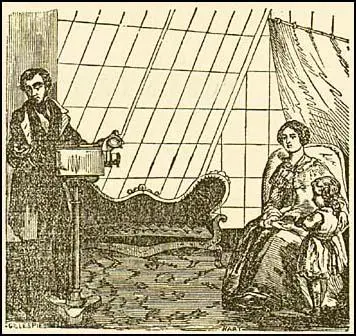
Engraving showing a photographer's
studio with a skylight.(c1853)
|
.
Early
in 1854, Farmer built a photographic glasshouse at 59 North
Street. In the previous year, Farmer had taken his daguerreotype
portraits "in a room designed and built expressly
for the purpose." On 7th February 1854, in the Brighton
Examiner, Robert Farmer announced that his daguerreotype
portraits would now be taken "in a Glasshouse, recently
constructed on scientific principles, at his Old-Established
Photographic Rooms, 59 North-Sreet, Brighton".
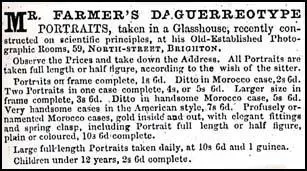
Advertisement in the Brighton
Examiner publicising Farmer's
Photographic Glasshouse.(7 February 1854)
|
Where possible, Farmer kept his prices below the rates charged by
his competitors. At the General Photographic Institution, St James
Street Brighton, where the photographic partnership of Grey &
Hall carried on their business, "daguerreotypes warranted
to last" started from 6 shillings (30 p.). James Henderson,
who opened a studio in New Road, Brighton in August 1855, charged
"10s 6d upwards" for a photographic portrait. In the same
period, Robert Farmer charged 1s 6d (71/2p)
for a small daguerreotype portrait in a plain frame.
|
Portrait
of an old Hero
William
Constable of the Original Photographic Institution wrote
that he had "many sitters from the ranks that are called
noble". The Brighton Gazette of 12th October 1854, reported
that Hennah & Kent's Talbotype Gallery had made portraits
of a number of "distinguished persons" including the
Duke of Devonshire, Countess Granville, Lord Carnworth and Lady
Keats. The majority of Farmer's customers must have been drawn
from lower down the social scale. However, in 1854 Farmer achieved
a major coup when he secured a portrait of Sir Charles Napier.
As the famous British army general, Sir Charles James Napier,
the conqueror of the province of Sind, had died in 1853, we
must assume that the Sir Charles Napier who patronised Farmer's
studio in 1854 was Vice Admiral Napier, who had recently been
given command of the Baltic Fleet. In March 1854, Admiral Sir
Charles Napier left Portsmouth with his fleet for the northern
seas of the Baltic, where it was hoped he would influence the
outcome of the Crimean War. Unfortunately for Farmer, Admiral
Napier returned to Engtland in December 1854 in some disgrace
for failing to attack the Russian stronghold of Kronstadt. If
Napier had returned a hero, Farmer could have capitalized on
Napier's patronage.
|
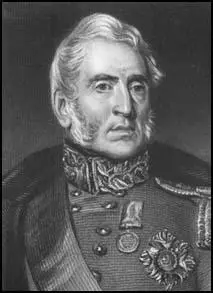
Portrait of Sir Charles
Napier (1854)
|
Mr
Farmer - A prolific and innovative Advertiser
Robert Farmer obviously believed in the effectiveness of advertising.
From 1853 to 1857, Farmer advertised continuously in the local press
and on the evidence available it appears he placed more newspaper
advertisements than any other photographer during this period.
William Constable, the first photographer in Brighton, rarely
advertised his services. Apart from his initial announcement on 9th
November 1841 that his Photographic Institution was now open to the
public, Constable hardly ever felt the need to advertise. In the 1840s
he had no competitors and so advertising seemed unnecessary. After
Prince Albert patronised his studio at 57 Marine Parade, it became
fashionable to have a likeness taken at Constable's Photographic Institution.
Constable wrote "the persons who have been once, come again and
bring their friends". As Philippe Garner, an authority on William
Constable's photographic career has noted, "Constable's reputation
was established by example and word of mouth". After the newspaper
advertisements in November 1841, announcing the opening of Brighton's
first photographic portrait studio, Constable only resorted to advertisements
in the local press when it was absolutely necessary. For example in
the summer of 1854, Constable posted notices in Brighton's newspapers
to inform the public that he had removed his place of business from
57 Marine Parade to 58 Kings Road. Very few other advertisements were
placed by Constable over the twenty years he was in business as a
photographic artist.
Hennah & Kent, another successful photographic portrait
studio active at the same time as Farmer, also seemed reluctant to
advertise in the local press. The firm of Hennah & Kent was held
in high regard and the partnership aparently was content to let others
sing their praises. The name of Hennah & Kent does appear in local
newspapers, but it is usually in the editorial columns or in a journalist's
review of their work. For example, on 12th October 1854, a writer
in the Brighton Gazette notes that those who have visited Hennah
& Kent's Talbotype Gallery at 108 Kings Road, "need not be
told that here portraits are taken in the very highest style of photographic
art". As long as Hennah & Kent could rely on unsolicited
praise and recommendations, advertising was superfluous.
Hennah & Kent's Talbotype Gallery and William Constable's Photographic
Institution were high class establishments that numbered Dukes and
Countesses and other "distinguished persons" amongst their
clientele and both firms probably regarded newspaper advertising as
rather vulgar. Robert Farmer could not afford to take such a haughty
attitude and quickly realised that his livelihood depended on regular
adverts in the press.
It is fortunate for the photohistorian that Robert Farmer placed so
many detailed advertisements in the local press. In the absence of
letters, journals and other documents, Robert Farmer's photographic
activities can only be measured by studying the material contained
in his newspaper ads.
Farmer's advertisements are particularly useful in gaining information
about the scale of charges adopted by daguerreotypists in the 1850s.
A number of advertisements placed by Farmer in the early months of
1854 give us an idea of the range of daguerreotype portraits available
to the customer :
|
Ed
TYPES OF DAGUERREOTYPES
AND PRICES
A
small daguerreotype portrait in a frame - 1s 6d
[SEE
ILLUSTRATION AT RIGHT]
A small daguerreotype portrait in a leather case 2s 6d
A larger size daguerreotype portrait in a frame- 3s 6d
A larger size daguerreotype portrait in a leather case - 5s
6d
Two daguerreotype portraits in one case -4s or 5s 6d
[SEE ILLUSTRATION AT RIGHT]
A daguerreotype portrait in an American thermo-plastic
case - 7s 6d
A daguerreotype portrait in an ornamented leather case with
elegant fittings and spring clasp - 10s 6d
[SEE ILLUSTRATION AT RIGHT]
Stereoscopic daguerreotype portrait complete with stereoscope
10s 6d
Large full length daguerreotype portraits 10s 6d or 15s
|
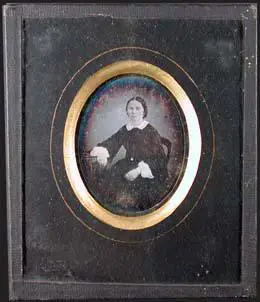
[ABOVE] Daguerreotype
portrait in a simple French frame1
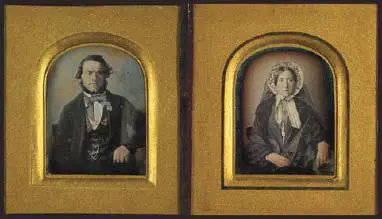
[ABOVE]
A pair of daguerreotypes in one case.
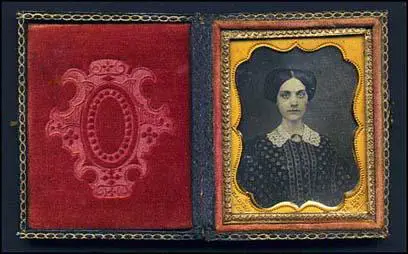
[ABOVE ] A
daguereotypeportrait of a woman in an elegant case
|
It must be remembered that Farmer was not a typical Brighton daguerreotypist,
in that the charges he made were generally lower than the average.
In 1855, when
Sussex photographers
were charging from 2s 6d to 10s 6d for their cheapest daguerreotype
portrait, Farmer was charging only 1s 6d. In one advertisement, Farmer
makes it clear how he was able to charge so little for his daguerreotype
portraits :
" Mr Farmer wants it to be understood that his portraits at
1s 6d are
equally as good in point of perfection as those of a more expensive
character, the only difference being that they are small and fitted
up
in plain frames. "
1st February 1855 BRIGHTON GAZETTE
|
Ed
Post
Mortem Daguerreotypes
In the 1840s and 1850s, it was not uncommon to make daguerreotypes
of the dead. On 3rd February 1855, Robert Farmer placed the
following notice in the Brighton Herald :
" R.F. informs the public and his patrons that he takes
portraits of
deceased persons at moderate charges."
It is significant that Farmer mentions that his post mortem
portraits were made " at moderate charges." Usually,
daguerreotype portraits of the dead were far more expensive
than ordinary portraits. The daguerreotypist would have to come
to the subject and a visit to a family home would mean added
expense for the photographer.
|
1
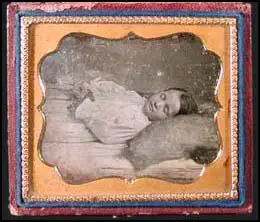
[ABOVE]
Daguerreotype of a dead child.(c1855)
|
Farmer's Advertising Rhymes
In 1855, Robert Farmer began to employ rhymes in his advertising.
The verses are plain and simple, but they have a certain charm and
prefigure the modern advertising jingle with their straightforward
rhymes:
Rambling up North Street t'other day,
I thus, unto myself did say-
"I'll have my portrait taken here,
They're good, and none can say they're dear.
So in I went, and in a trice,
They gave me this, isn't it nice?
BRIGHTON GAZETTE, 11 January 1855
Somewhat surprisingly, Farmer never ran the same poem twice, even
when advertising in different newspapers. For example, two days after
the above rhyme apeared in the Brighton Gazette, Farmer placed the
following verse in the Brighton Herla.d
Young Edward to his brother said,
I'll have my portrait taken, Fred;
And so will I, Fair Ellen cried,
Her father's joy, her mother's pride,
We'll give them to our parents dear,
And have them taken, I know where
BRIGHTON HERALD, 13 January 1855
Occasionally the poems contain details which indicate the attributes
looked for in a daguerreotype:
A good Daguerreotype, if you please,
Possess qualities like these;
Clear, sharp and well defined, and better,
A brilliant tone, true to the letter.
Good blacks and whites and, take the hint,
Mounted and coloured to a tint.
BRIGHTON GAZETTE, 18th January 1855
Another rhyme points out the advantages of a sea-side location over
England's capital, where smog and pollution of the air was believed
to affect the quality of photographic images.
No, London smoke and Brighton air
Will not for Photographs compare,
The reason is, the atmosphere
BRIGHTON GAZETTE, 3rd April 1856
Group
Photographs
In January 1855 Farmer placed the following rhyming advertisement
in a local newspaper:
A darling little child we take,
With dimple cheeks - there's no mistake;
Or two or three with mother kind,
We group them, prettily defined.
Whole families we group together,
And take them, dull or fine the weather
BRIGHTON HERALD 27th January 1855
In the 1850s, when exposure times were lengthy, making portraits of
children or a group of several figures were regarded as difficult
operations. In 1853, Robert Farmer advertised that the time of a sitting
was ten seconds. To make a good portrait of a child or a large family
group necessitated skill and patience and Robert Farmer introduced
a scale of charges that reflected the additional effort required.
Farmer charged 1s 6d (71/2p) for a single portrait
of a man or woman, but a portrait of a child under 10 years would
cost 2s 6d (121/2p), a group of three children,
7s 6d (371/2p) and the price of a portrait of
a family group made up of five people was fixed at 10s 6d (521/2p)
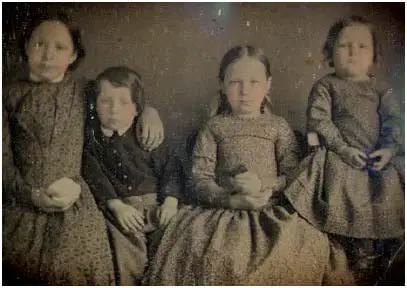
Daguerreotype
of a group of children made by an unknown photographer in the 1850s.
Robert Farmer in the Collodion Age 1856-1859
By the Spring of 1856, Robert Farmer had finally abandoned the
daguerreotype and was employing a collodion 'wet plate' process
based on Frederick Scott Archer's invention of 1851.
In an advertisement dated 3rd April 1856, Farmer acknowledged that
he was now taking advantage of "the great improvements that have
recently taken place in the Photographic Art".
The collodion 'wet plate' process was not easy to use, but it was
less costly than the daguerreotype.
Farmer introduced a new scale of charges to reflect "the moderate
price the best portraits can now be obtained", even "with
ample renumeration to the Artist". A photographic portrait in
an "elegant French case" at Farmer's Photographic Institution
now cost one shilling (5 p.). Farmer's old rival, William Lane,
who was operating the Verreotype Photographic Portrait Rooms in 1856,
was offering a similar portrait for 1s 6d (71/2p.)
By November 1857, Robert Farmer had opened a second photographic gallery
at 62 North Street, which he called his 'Model Photographic
Establishment'. Apparently, Farmer was obliged to open a second gallery
because of the demand from his "numerous patrons" at his
original photograhic gallery at 59 North Street. The availability
of a second gallery relieved pressure on the older establishment and
Farmer was able to reassure his customers that "visitors are
not now detained as was too often the case previous to the opening
of No 62."
An Early Death
Robert Farmer had advertised regularly and extensively in the local
press from 1853 to 1857. In Melville & Co's Directory of 1858,
there was by Robert Farmer's standards a very basic advertisement
which read simply 'FARMER'S PHOTOGRAPHIC PORTRAITS - From One Shilling
to One Guinea - TAKEN DAILY AT BOTH ESTABLISHMENTS, 59 AND 62 NORTH
STREET, BRIGHTON. In the Brighton Gazette of 17th March
1859 there appeared an equally brief and simple notice "DIED
- On the 12th Inst at Burgess Hill, Robert Farmer, of 59 North Street,
Brighton, photographic artist, aged 36 years."
It is likely that Robert Farmer would have continued to have been
a central figure in the history of photography in Brighton, but for
his early death on 12th March 1859. The carte de visite format,
which boosted the fortunes of portrait photographers in Brighton in
the 1860s. had recently been introduced into England. Given Farmer's
business acumen, there is no reason to doubt that he would have exploited
the commercial potential of the cdv format, which was, after all,
in keeping with Farmer's aim of providing photographic portraits at
the lowest price possible.
Farmer's Legacy
By 1861, Farmer's studio at 59 North Street Brighton was in
the hands of William J. Collings, a 24 year old photographic
artist from Camberwell. Collings' tenure at 59 North Street was brief.
When Folthorp's Directory of Brighton was compiled in May 1862, the
studio at 59 North Street was occupied by William Clark, a
31 year old Hampshire born photographer, who had previously worked
in Winchester. William Clark remained at 59 North Street for over
twenty years until 1884.
Robert Farmer was an important figure in the early history of photography
in Brighton, but very few authenticated images by this pioneer photographer
have survived. However, his surname is forever linked to photographic
history through the contribution of his son, Ernest Howard Farmer
(1856-1944) who became a 'teacher of photography' and was appointed
the first Head of Photography at the Regent Street Polytechnic (now
part of the University of Westminster.)
Ernest Howard Farmer was Robert Farmer's second son. Ernest trained
as a physicist, but as a young man he was experimenting with photography.
In 1883, Ernest H Farmer invented a chemical method to reduce the
intensity of a photographic negative. Ernest Farmer combined potassium
ferricyanide with sodium thiosulphate to decrease the silver in a
developed image. Ernest Farmer's formula is still used in photography
today to lighten over exposed negatives or reduce the density of a
black and white print. The chemical solution was given the name 'Farmer's
Reducer' and so despite his early death and through the achievements
of his son, the name of Farmer will be preserved in photographic history.
|
Ed
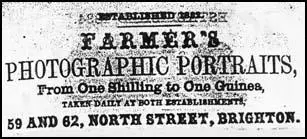
ABOVE LEFT ] Advertisement
in Melville's 1858 Directory of Brighton in which Robert Farmer
mentions both his studios in North Street, Brighton. By this
time, Farmer was using the collodion process to make photographic
likenesses and could offer portraits for as little as one shilling
( 5p ).
|
1
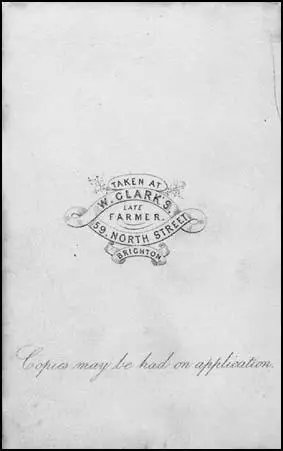
(ABOVE RIGHT)The
back of a William Clark carte de visite shows Robert Farmer's
original trade plate for his studio at 59 North Street, Brighton.
|
Website
last updated : 23, January 2003